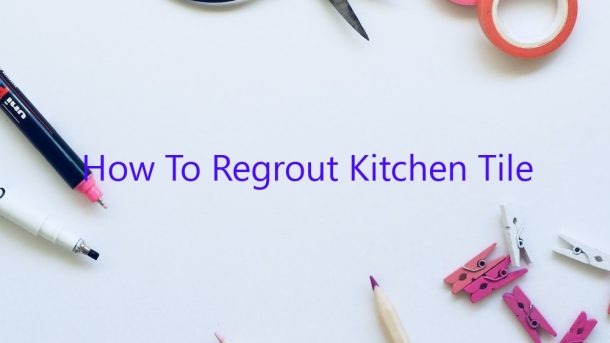A kitchen is one of the most important rooms in a home. It’s where we cook and eat, so it’s important that it’s always looking its best. If your kitchen tiles are looking a bit worse for wear, don’t worry – regrouting them is a relatively easy process that can give your kitchen a fresh new look.
The first step is to remove the old grout. This can be done with a screwdriver or chisel. Be careful not to damage the tiles in the process. Once the old grout is gone, you can start to prepare the new grout.
Mix the grout according to the manufacturer’s instructions. It’s important to get the mix right, as too much or too little grout can cause problems.
Once the grout is ready, use a grout float to apply it to the tiles. Make sure to press it into the cracks between the tiles and remove any excess grout.
Let the grout dry for 24 hours, then apply a sealant. This will help to protect the grout and keep it looking good for longer.
That’s all there is to it! By following these simple steps, you can easily regrout your kitchen tiles and give your kitchen a fresh new look.
Contents [hide]
Can you put new grout over old grout?
In the world of home improvement, there are a lot of questions that come up about what can and can’t be done. One common question is whether or not it’s possible to put new grout over old grout. The answer to this question is a little bit complicated.
In short, it is possible to put new grout over old grout, but it’s not always recommended. The main reason why it’s not always recommended is because the new grout may not adhere to the old grout very well. This can lead to the new grout cracking or peeling off over time.
If you decide to go ahead and put new grout over old grout, there are a few things that you can do to increase the chances of it sticking. First, make sure that the old grout is completely clean and free of any dirt or debris. Second, use a good-quality adhesive to help stick the new grout to the old grout.
If you’re not comfortable putting new grout over old grout, another option is to remove the old grout and replace it with new grout. This is a more time-consuming process, but it will give you a much better chance of the new grout sticking properly.
In the end, it’s up to you whether or not you want to try putting new grout over old grout. If you do decide to give it a try, just be sure to take the necessary precautions to increase the chances of it sticking.
Do I have to remove all old grout before Regrouting?
Do I have to remove all old grout before Regrouting?
There is no definitive answer to this question as it depends on the condition of the old grout and the new grout that is being used. In some cases, the old grout may need to be completely removed before the new grout can be applied. In other cases, it may be possible to just remove the loose or damaged grout and then regrout over the existing grout.
If the old grout is in good condition and still securely attached to the tile, it may be possible to just remove the damaged or loose grout and then regrout over the existing grout. This can be done using a grout saw to cut away the damaged grout and a grout float to apply the new grout. However, if there is any evidence of deterioration or damage to the old grout, it is best to remove all of the old grout and start fresh.
If the old grout is in poor condition and needs to be replaced, it is best to remove all of the old grout and start fresh. This can be done using a grout saw to cut away the old grout and a grout float to apply the new grout. Be sure to clean the surface of the tile thoroughly before applying the new grout.
How hard is it to Regrout kitchen tile?
If your kitchen tile is starting to look a little worse for wear, regrouting it may be the solution. Regrouting is the process of removing the old grout from between the tiles and replacing it with new grout. This can be a challenging job, but with the right tools and techniques, it’s a job that most people can do themselves.
The first step is to remove the old grout. This can be a challenging task, as the old grout is likely to be quite brittle and may crumble or break off when you try to remove it. One way to make this process a little easier is to use a scoring tool to score the grout lines before you start to remove it. This will help to weaken the grout and make it easier to remove.
Once the old grout is removed, you can start to prep the tile for the new grout. This includes cleaning the tile and removing any old adhesive or sealant. Once the tile is clean and dry, you can start to apply the new grout.
The most important thing when applying the new grout is to make sure that it is applied evenly and that there are no gaps or air bubbles. You can use a rubber grout float to help spread the grout and ensure an even coverage.
Once the grout has dried, you can seal it with a grout sealant. This will help to protect the grout from staining and fading.
How do you Regrout kitchen counter tiles?
If you’ve noticed that the grout between your kitchen counter tiles is starting to look a bit grimy or stained, it may be time to re-grout them. Re-grouting is a fairly simple process that can be done with just a few basic tools, and it can make your kitchen counters look like new again.
The first step is to remove the old grout. This can be done with a grout saw, a grout rake, or even a utility knife. Be careful not to damage the tiles while you’re removing the grout.
Once the old grout is gone, you can start to prepare the area for new grout. You’ll need to clean the surface of the tiles and the joints thoroughly, and then you’ll need to apply a grout sealer to the area.
Once the sealer is dry, you can start to apply the new grout. Use a grout float to apply the grout to the joints, and be sure to press it into the joints well. Allow the grout to dry for 24 hours, and then seal it with a grout sealer.
Your kitchen counters should now look like new again!
Is it worth Regrouting tiles?
In general, regrouting tiles is not a necessary task. If the grout is in good condition and the tiles are still firmly attached, then there is no need to regrout. However, if the grout is loose, cracked, or faded, then regrouting may be the best option.
Before deciding whether or not to regrout, it is important to determine the extent of the damage. If the grout is only slightly loose or faded, then a simple cleaning and re-grouting may be all that is necessary. If the grout is cracked or completely missing, then a full renovation may be required.
If regrouting is necessary, then the first step is to remove the old grout. This can be done with a grout removal tool, or by using a drill with a grout removal bit. Once the old grout is removed, the tiles should be cleaned and dried.
The new grout should then be mixed according to the manufacturer’s instructions. It is important to use the correct type of grout for the tiles, as different types of grout can vary in terms of strength, color, and porosity.
The grout should be applied to the tiles using a grout float, and then it should be smoothed out with a damp sponge. Once the grout has dried, it should be sealed with a sealant designed for grout.
Is it easy to Regrout tiles?
Is it easy to Regrout tiles?
That is a question that many people ask, and the answer is that it depends on the situation. In some cases, it is easy to regrout tiles, while in others it is more difficult. Here is a closer look at the regrouting process, along with some tips to make it easier.
What is Regrouting?
Regrouting is the process of removing the old grout from between tiles and replacing it with new grout. This is often necessary when the old grout starts to crack, crumble, or peel.
How to Regrout Tiles
If you are going to regrout tiles yourself, here is what you need to do:
1. Remove the old grout. This can be done with a chisel and hammer, or with a grout removal tool.
2. Clean the tile surfaces. This can be done with a wire brush or a scraper.
3. Apply a thin layer of mortar to the tile surfaces.
4. Insert the new grout into the mortar.
5. Use a grout float to smooth the grout and remove any excess.
6. Allow the grout to dry.
7. Seal the grout with a grout sealer.
It is also a good idea to wear gloves and eye protection while grouting.
Tips for Regrouting Tiles
Here are some tips to make the regrouting process easier:
1. Choose the right grout for the project. There are several types of grout, and each one is best suited for a particular application.
2. Apply the mortar to the tile surfaces with a trowel. This will help to ensure that the grout is applied evenly and that there are no air bubbles.
3. Use a grout float to apply the grout. This will help to smooth out the grout and remove any excess.
4. Allow the grout to dry before sealing it. This will help to prevent staining.
5. Seal the grout after it has dried. This will help to protect it from moisture and staining.
How deep do you need to remove grout to Regrout?
When regrouting tile floors or walls, it’s important to remove the old grout completely. This ensures a solid bond between the new grout and the tile. How deep you need to remove the grout depends on the type of grout and the condition of the tile.
With most types of grout, you should remove at least 1/8 inch of the old grout. If the grout is severely cracked or the tile is in bad shape, you may need to remove more. Be sure to clean the surface of the tile well before applying the new grout.




